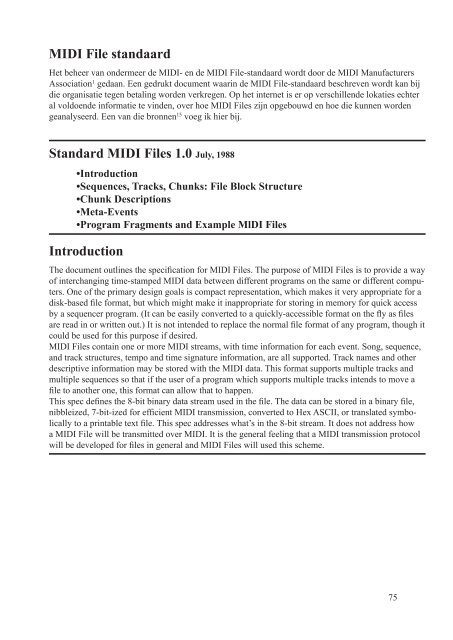2.3 Relaxatie-oscillator
2.3 Relaxatie-oscillator
2.3 Relaxatie-oscillator
You also want an ePaper? Increase the reach of your titles
YUMPU automatically turns print PDFs into web optimized ePapers that Google loves.
MIDI File standaard<br />
Het beheer van ondermeer de MIDI- en de MIDI File-standaard wordt door de MIDI Manufacturers<br />
Association 1 gedaan. Een gedrukt document waarin de MIDI File-standaard beschreven wordt kan bij<br />
die organisatie tegen betaling worden verkregen. Op het internet is er op verschillende lokaties echter<br />
al voldoende informatie te vinden, over hoe MIDI Files zijn opgebouwd en hoe die kunnen worden<br />
geanalyseerd. Een van die bronnen 15 voeg ik hier bij.<br />
Standard MIDI Files 1.0 July, 1988<br />
•Introduction<br />
•Sequences, Tracks, Chunks: File Block Structure<br />
•Chunk Descriptions<br />
•Meta-Events<br />
•Program Fragments and Example MlDI Files<br />
Introduction<br />
The document outlines the specification for MIDI Files. The purpose of MIDI Files is to provide a way<br />
of interchanging time-stamped MIDI data between different programs on the same or different computers.<br />
One of the primary design goals is compact representation, which makes it very appropriate for a<br />
disk-based file format, but which might make it inappropriate for storing in memory for quick access<br />
by a sequencer program. (It can be easily converted to a quickly-accessible format on the fly as files<br />
are read in or written out.) It is not intended to replace the normal file format of any program, though it<br />
could be used for this purpose if desired.<br />
MIDI Files contain one or more MIDI streams, with time information for each event. Song, sequence,<br />
and track structures, tempo and time signature information, are all supported. Track names and other<br />
descriptive information may be stored with the MIDI data. This format supports multiple tracks and<br />
multiple sequences so that if the user of a program which supports multiple tracks intends to move a<br />
file to another one, this format can allow that to happen.<br />
This spec defines the 8-bit binary data stream used in the file. The data can be stored in a binary file,<br />
nibbleized, 7-bit-ized for efficient MIDI transmission, converted to Hex ASCII, or translated symbolically<br />
to a printable text file. This spec addresses what’s in the 8-bit stream. It does not address how<br />
a MIDI File will be transmitted over MIDI. It is the general feeling that a MIDI transmission protocol<br />
will be developed for files in general and MIDI Files will used this scheme.<br />
75


